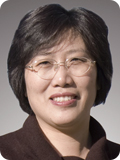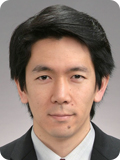Plenary Lecture
Plenary Session1: Oct. 17(WED) 11:00~12:00, Blisshill Stay

Human Performance Monitoring and Simulation
Matthew W, Smuck
Stanford University, USA
People with mobility limitations can benefit from exoskeletons and prostheses, but real-life applications of these technologies remain limited. One factor that limits their common application and advancement in the clinical realm is a poor definition of improved performance from these interventions. This problem is shared with all other technologies and treatments designed to improve the functional status of people with orthopedic and neurologic mobility limitations. This talk will review one solution to this problem, the emerging field of physical performance monitoring, where body-worn sensors provide accurate and clinically relevant feedback. This approach has led to new methods of monitoring and diagnosing mobility limitations, new insights into mechanisms of disease, and continuous variables to inform mobility interventions.
¯¯¯¯¯¯¯¯¯¯¯¯¯¯¯¯¯¯¯¯¯¯¯¯¯¯¯¯¯¯¯¯¯¯¯¯¯¯¯¯¯¯¯¯¯¯¯¯¯¯¯¯¯¯¯¯¯¯¯¯¯¯¯¯¯¯¯¯¯¯¯¯¯¯¯¯¯¯¯¯¯¯¯¯¯¯¯¯¯¯¯¯¯¯¯¯
Plenary Session2: Oct. 17(WED) 14:00~15:00, Blisshill Stay
 Machine Learning Algorithm and Its Application Software
Machine Learning Algorithm and Its Application Software
Xiaoyan Zhu
Tsinghua Univ., China
This talk will start from the origin, classification and other basic problems of machine learning algorithms, and discuss the various performance of machine learning algorithms in different eras, different scenarios and different tasks. The pros and cons of neural network based deep learning algorithms in big data environment are analyzed. The importance and necessity of big data for the acquisition of machine intelligence. Finally, an applicable case of conversational AI is given.
¯¯¯¯¯¯¯¯¯¯¯¯¯¯¯¯¯¯¯¯¯¯¯¯¯¯¯¯¯¯¯¯¯¯¯¯¯¯¯¯¯¯¯¯¯¯¯¯¯¯¯¯¯¯¯¯¯¯¯¯¯¯¯¯¯¯¯¯¯¯¯¯¯¯¯¯¯¯¯¯¯¯¯¯¯¯¯¯¯¯¯¯¯¯¯¯
Plenary Session3: Oct. 18(THU) 11:00~12:00, Blisshill Stay
 Automatic Generation and Formal Verification of Safe PLC Programs for Railway Control Systems
Automatic Generation and Formal Verification of Safe PLC Programs for Railway Control Systems
Janan Zaytoon
University of Reims, France
This lecture deals with research activities in partnership with SNCF (French Railway Company) to develop an integrated methodology for automatic generation, formal verification and implementation of safe PLC programs for Railway Control Systems. The first phase of the methodology focuses on the improvement of the engineering workflow during the design phase of the control system of the Power Supply Equipment of the Electric Lines (PSEEL). It results in a standardized generation of the control deliverables, including wiring diagrams and PLC programs. The second phase of the methodology is related to the application of formal verification and/or control synthesis techniques to guarantee the safety of the control installation. The verification procedure is used in place of the manual testing approaches to verify the conformity of the PLC programs with respect to safety properties that are defined by the expert. The verification is based on automatically generated models of the PSEEL, the PLC programs and PLC scan cycle. The control synthesis procedure consists of designing a robust filter to be used in conjunction with the PLC program in such a way to guarantee the generation of safe PLC-program outputs. This methodology results in: i) improving the “overloaded” workflow of systems engineers, while reducing the fatigue and stress, and ii) enhancing the system reliability due to the reduction of breakdowns on site.
¯¯¯¯¯¯¯¯¯¯¯¯¯¯¯¯¯¯¯¯¯¯¯¯¯¯¯¯¯¯¯¯¯¯¯¯¯¯¯¯¯¯¯¯¯¯¯¯¯¯¯¯¯¯¯¯¯¯¯¯¯¯¯¯¯¯¯¯¯¯¯¯¯¯¯¯¯¯¯¯¯¯¯¯¯¯¯¯¯¯¯¯¯¯¯¯
Plenary Session4: Oct. 18(THU) 14:00~15:00, Blisshill Stay

Optimization in Machine Intelligence
Edwin K. P. Chong
Colorado State Univ., USA
We discuss the role of optimization methods in modern machine intelligence. More specifically, we describe a general class of decision/control strategies called state-dependent action optimization (SDAO). We outline theoretical and applied research issue related to SDAO. On the theoretical side, we introduce a framework based on optimal control and show that, under quite general conditions, there exists an optimal solution (policy or controller) that is also an SDAO scheme. This result, not usually stated this way and more commonly known as Bellman’s principle, makes SDAO schemes of interest in a wide range of applications and is the basis for self-driving vehicles and AlphaGo, the master-beating Go playing machine. We then show how to use results from submodular optimization to bound the performance of SDAO schemes relative to the optimal. We describe several application examples in which such schemes have been applied, and also outline some ongoing applications.
¯¯¯¯¯¯¯¯¯¯¯¯¯¯¯¯¯¯¯¯¯¯¯¯¯¯¯¯¯¯¯¯¯¯¯¯¯¯¯¯¯¯¯¯¯¯¯¯¯¯¯¯¯¯¯¯¯¯¯¯¯¯¯¯¯¯¯¯¯¯¯¯¯¯¯¯¯¯¯¯¯¯¯¯¯¯¯¯¯¯¯¯¯¯¯¯
Plenary Session5: Oct. 19(FRI) 11:00~12:00, Blisshill Stay
 Distributed Randomized Algorithms for PageRank Computation: Recent Advances
Distributed Randomized Algorithms for PageRank Computation: Recent Advances
Hideaki Ishii
Tokyo Inst. of Tech., Japan
PageRank is a well-known centrality measure for the web used in search engines, representing the importance of each web page. Its computation is very large scale as the rankings for all pages in the entire web are to be calculated at once, and this has prompted various studies on the algorithmic aspects of this problem. In this talk, we first present a short overview on the the problem and recent studies on distributed algorithms that have been developed in the systems control area. These algorithms are motivated by the research on collaborative control of multi-agent systems and share the following features: (i) each page computes its own PageRank value by interacting with pages connected over hyperlinks and (ii) gossip-type randomization is employed in their communications. Then, we introduce a new class of distributed algorithms, which is based on a simple but novel interpretation of PageRank. It is demonstrated via analysis and numerical simulations that these algorithms have significant advantages in their convergence performances in comparison with other existing techniques. In the last part, we discuss the works on randomization-based distributed algorithms from a broader perspective.










